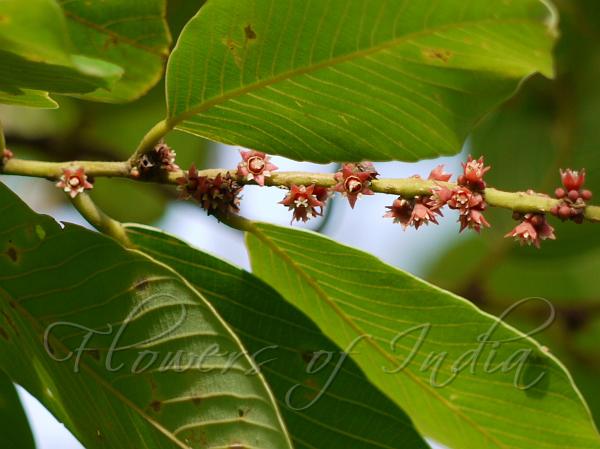|
| Spinous Kino Tree |
|

|

| File size | 364063 |
| Original date | 8/30/09 8:53 AM |
| Resolution | 2048 x 1536 |
| Flash | Flash did not fire, auto |
| Focal length | 200.0mm |
| Exposure time | 1/250s |
| Aperture | 5.6 |
| Focus Distance | |
| Metering Mode | Multi-segment |
| Camera make | Panasonic |
| Camera model | DMC-G1 |
| Sensor type | OneChipColorArea |
|
|
|
|
Photo: |
Botanical name: Bridelia retusa Family: Phyllanthaceae (Amla family)
Spinous Kino Tree is identified by rigid leathery leaves with straight
parallel lateral veins and strong spines on the bark of young stems. It is
a drought hardy species, produces root-suckers and a good coppicer.
Leaf-blade is elliptic-oblong to elliptic-oblanceolate, 10-20 x 4-10 cm,
tip somewhat pointed, sometimes blunt, base is rounded or roundly wedge-shaped,
margin entire or wavy, thinly leathery, lateral nerves 15-20 pairs.
Flowers are arranged in axillary fascicles and also in fascicles on leafless
branches appearing as spikes. The fascicles are either unisexual or
bisexual; axes densely puberulous; bracts small, acute; flowers stalked.
Fruit is globose, fleshy sweetish drupe, about the size of a pea,
purple-black, seated on a hard enlarged calyx. 1 or 2 seeds with fairly
thick bony shells. Distributed throughout India, in hotter parts
along the base of the Himalayas from Kashmir to Mishmi, southward to
Ceylon. Flowering: May-August.
Medicinal uses: The plant is pungent, bitter, heating, useful in
lumbago, hemiplegia; bark is good for the removal of urinary concretions
(Ayurveda). Root and bark are valuable astringents. The bark is used as a
liniment with gingelly oil in rheumatism.
The plant is pungent, bitter, heating, useful in
lumbago, hemiplegia; bark is good for the removal of urinary concretions
(Ayurveda). Root and bark are valuable astringents. The bark is used as a
liniment with gingelly oil in rheumatism.
Medicinal uses:
 The plant is pungent, bitter, heating, useful in
lumbago, hemiplegia; bark is good for the removal of urinary concretions
(Ayurveda). Root and bark are valuable astringents. The bark is used as a
liniment with gingelly oil in rheumatism.
The plant is pungent, bitter, heating, useful in
lumbago, hemiplegia; bark is good for the removal of urinary concretions
(Ayurveda). Root and bark are valuable astringents. The bark is used as a
liniment with gingelly oil in rheumatism.
| Identification credit: Dinesh Valke | Photographed at Sanjay Gandhi National Park, Mumbai & Jharkhand. |
• Is this flower misidentified? If yes,